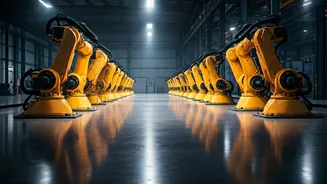Hoarding's Decline Unveiled
Historically, corporations often held onto employees, even during economic downturns, a practice known as labor hoarding. This was driven by a desire to retain
skilled workers and avoid the costs associated with hiring and training new employees when the economy improved. However, several factors now contribute to the decline of this practice. Increased automation, for example, allows companies to do more with fewer employees, diminishing the need to keep underutilized staff. Furthermore, the rise of the gig economy and contract work provides companies with flexible labor options, making it easier to scale their workforce up or down as needed. The focus now is on efficiency and agility rather than retaining excess labor. The COVID-19 pandemic also played a significant role, as many companies were forced to reassess their staffing levels and embrace remote work models, leading to a leaner approach.
Ruthlessness's Rise Defined
The shift away from labor hoarding coincides with a rise in what some might call 'ruthlessness' within Corporate America. This manifests in several ways, including increased layoffs, a greater emphasis on performance-based compensation, and a willingness to eliminate underperforming divisions or employees. The drive for shareholder value and short-term profits is a major factor driving this behavior. Companies are under constant pressure to cut costs and boost earnings, which often leads to decisions that prioritize efficiency over employee loyalty. Globalization and increased competition also play a role, as companies must be more nimble and adaptable to survive in a rapidly changing business environment. The use of data analytics to monitor employee performance has also created an environment where underperformance is quickly identified and addressed, contributing to a more demanding and results-oriented work culture.
Impact on Employees Explored
The end of labor hoarding and the rise of a more ruthless approach have significant implications for employees. Job security is diminished, and workers are more likely to face layoffs or performance-based terminations. There is a growing need for employees to constantly upskill and reskill to remain competitive. The pressure to perform at a high level also increases, leading to higher stress levels and potential burnout. On a positive note, this shift can also create opportunities. Companies are more likely to invest in top talent and offer competitive compensation packages to attract and retain the best employees. The focus on efficiency might lead to improved processes and greater productivity, potentially benefiting the entire workforce. Employees must adapt to this changing landscape. They should focus on developing skills that are in demand, staying flexible, and actively managing their careers. They need to understand the realities of today's work environment and adapt to thrive in it.
Turning Point Significance
The end of labor hoarding and the emergence of a more ruthless approach represent a significant turning point in the history of Corporate America. This shift is reshaping the relationship between companies and their employees and affecting the broader economy. It reflects broader trends, including automation, globalization, and increased competition. The consequences extend beyond individual companies. It affects wage growth, income inequality, and the overall stability of the workforce. Policy decisions, such as those related to labor laws, education, and social safety nets, will be crucial in mitigating the negative impacts of this trend and ensuring that the benefits of economic progress are shared more equitably. The future of work is being defined now. Understanding these shifts is essential for both businesses and employees to navigate the evolving landscape successfully and make informed decisions that shape the future.















